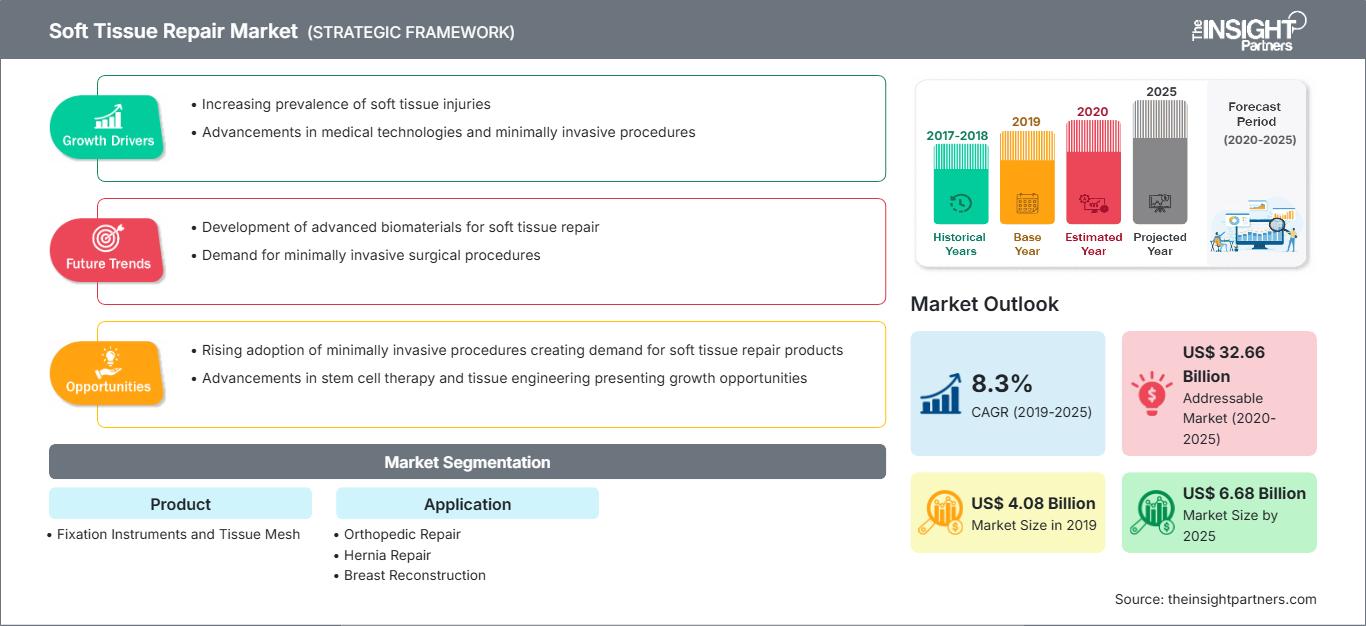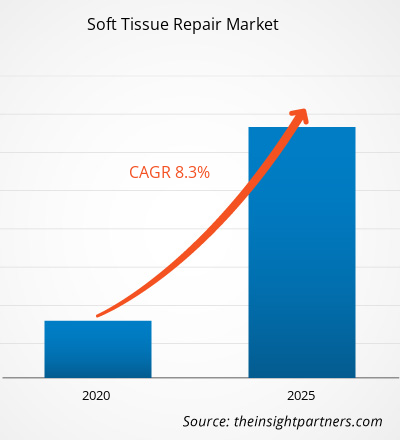[研究报告] 软组织修复市场规模预计将从 2019 年的 40.762 亿美元增长到 2025 年的 66.77 亿美元;预计 2020 年至 2025 年的复合年增长率为 8.3%。
分析师观点
预计在预测期内,人口老龄化和运动损伤将以惊人的速度增长。软组织损伤可能发生在体育运动和锻炼活动中,有时日常活动也会导致这些损伤。软组织修复是指使用各种医疗器械再生和重建软组织的一系列手术。全球老年人口的不断增长正在增加骨科软组织修复手术的使用。人们对此类损伤认识的提高以及公司推出软组织修复产品的努力预计将促进全球软组织修复市场的增长。 2022年5月,Paragon 28, Inc. 推出了 Grappler 缝合锚系统,以应对在急性足踝手术中进行软组织拉紧和韧带重建时出现的挑战。此外,高度先进的医疗设施和高昂的医疗支出正在推动各地区软组织修复市场的增长。
市场概览
皮肤、肌腱和韧带、关节滑膜组织、血管、淋巴管、周围神经、肌肉、神经和血管是人体中各种类型的软组织。拉伤、肌肉和/或肌腱拉伸或撕裂、韧带撕裂或拉伸、挫伤或擦伤、肌腱炎和滑囊炎是常见的软组织损伤,在运动员中最为常见。软组织修复涉及使用固定装置和组织网或补片。缝合线、缝合锚和干涉螺钉是用于软组织固定的一些固定装置。合成网片、同种异体移植和异种移植也用于替换身体各个部位缺失的软组织。由于成人和儿童软组织损伤数量的增加以及医院急诊服务的普及,对软组织修复器械的需求也在增长。运动损伤发生率的上升和骨科手术数量的增加是软组织修复市场的主要驱动力。此外,对运动医学和软组织损伤的日益关注也促进了软组织修复市场的增长。
自定义此报告以满足您的要求
您将免费获得任何报告的定制,包括本报告的部分内容,或国家级分析、Excel 数据包,以及为初创企业和大学提供超值优惠和折扣
软组织修复市场: 战略洞察

-
获取本报告的主要市场趋势。这个免费样本将包括数据分析,从市场趋势到估计和预测。
市场驱动因素
运动损伤患病率上升推动全球软组织修复市场增长
儿童、成人和老年人群中软组织损伤的数量有所增加。软组织损伤在运动员中也很常见,可能需要立即治疗。疾病控制和预防中心 (CDC) 表示,参加体育运动的成年人和青少年人数有所增加。根据约翰霍普金斯大学的数据,运动损伤在从事各种体育活动(如足球、篮球、足球、冰球和其他游戏以及田径运动)的成人和儿童中很常见。扭伤和拉伤、膝盖损伤、肌腱损伤、骨折、脱臼和肩袖损伤是一些常见的运动损伤。
由于参加体育运动的成年人人数不断增加,运动损伤的患病率也在上升。政府机构会开展调查,以确定特定领域中需要解决的常见运动损伤数量。根据国家安全委员会的数据,5-14 岁儿童占所有橄榄球损伤的 50%,足球损伤的 45%,以及棒球损伤的 44%。橄榄球造成的伤害最多,2018-19 年度约有 455,449 例。在所有由橄榄球造成的膝盖损伤中,最常见的是前交叉韧带 (ACL) 断裂。同年,足球造成了约 412,607 例伤害(包括男性和女性球员);其中估计 22% 的伤害是脑震荡。2021 年,近 57,600 例运动相关伤害是脑震荡。此外,2021 年约有 320 万人因运动和娱乐器材相关伤害在急诊室接受治疗。
篮球和足球等接触性运动的损伤发生率更高,因为这些运动涉及接触和碰撞,会导致关节、骨骼、肌腱和其他软组织严重受伤。此类损伤需要紧急治疗,甚至需要手术。根据 ValuePenguin 的研究数据,2021 年有超过 440 万例与篮球相关的损伤在急诊室接受治疗。紧随其后,足球是导致损伤的第二大常见运动,造成了 330 万人受伤,占所有运动相关损伤的 20%。根据美国骨科医师学会的估计,美国每年报告的 ACL 损伤有 20 万例,每年进行约 10 万例 ACL 重建手术。因此,与运动相关的软组织损伤数量正在增加,这反过来又推动了软组织修复市场的增长。
分段分析
根据产品,软组织修复市场细分为固定器械和组织网/补片。2019 年,固定器械细分市场在软组织修复市场中占有较大的份额。此外,预计同一细分市场在预测期内的复合年增长率将更高。在软组织修复过程中,使用各种固定装置将软组织固定到解剖结构的表面,例如骨骼,骨骼比软组织具有更高的强度和刚度。缝合线、缝合锚、干涉螺钉等是各种骨科手术中使用的主要固定装置类型。这些装置使医生能够在手术过程中保持组织张力。固定器械细分市场又细分为缝合锚、干涉螺钉、缝合线等。缝合锚细分市场在 2019 年占据了最大的市场份额,预计在预测期内将实现最高的复合年增长率。缝合锚用于软组织固定,尤其是在关节镜和疝修补手术中。目前,新推出的技术先进的缝合锚用于修复和优化肌肉骨骼组织,例如髋关节、膝关节、手关节、肘关节、足关节和踝关节。缝合锚有助于软组织与骨骼之间的愈合,因为由于骨骼上软组织不足,无法进行直接的软组织与软组织之间的修复。此外,软组织修复市场上的各种缝合锚都提供了牢固且更好的固定效果。无结缝合锚有助于将软组织固定到骨骼等坚硬结构上。缝合锚的内构件接收缝合线并在外管状构件内旋转。由于缝合锚内膜的旋转,缝合线被缠绕在内构件上。外管膜对所连接的线施加压力,以将线保持在内膜上的位置,从而实现组织缝合。
区域分析
2019 年北美软组织修复市场价值为 17.915 亿美元,预计到 2025 年将达到 29.946 亿美元;预计在预测期内复合年增长率为 8.7%。北美软组织修复市场分为美国、加拿大和墨西哥。2019 年,美国占据北美软组织修复市场的最大份额。该国软组织修复市场的增长主要得益于生物制剂在软组织修复和疝气修复等骨科手术中的使用增加。在美国,同种异体移植主要用于组织修复,因为外科医生普遍倾向于使用同种异体移植。根据Ortho Regenerative Technologies的数据,美国每年进行近60万例肩袖手术。根据美国运动医学骨科协会的数据,美国每年有近10万至25万例前交叉韧带断裂。此外,组织损伤也越来越受到重视,运动员对软组织损伤及其治疗的认识也越来越高。此外,乳腺癌在美国女性中也很常见。根据breastcancer.org的数据,在美国,近八分之一的女性(约12.4%)在其一生中会患上浸润性乳腺癌。截至2022年1月,美国有超过380万女性患有乳腺癌。根据美国整形外科医师协会 (ASPS)/整形外科基金会 2020 年的数据,2018 年美国约有 101,600 名女性接受了乳房重建。
此外,新产品的推出和研究资金也推动了美国软组织修复市场的增长。例如,2022 年 11 月,Novadip Biosciences 在 B 轮股权融资和非稀释性融资中额外筹集了 4103 万美元(4000 万欧元)。这笔资金加速了 Novadip 两种研究性脂肪干细胞 (ASC) 衍生组织再生产品的临床开发:NVD-X3 和 NVD-003。因此,预计上述因素将推动北美地区软组织修复市场的增长。
关键参与者分析
软组织修复市场分析包括 Smith & Nephew、Depuy Synthes 等参与者; Covidien(美敦力);Wright Medical Group, Inc.;CR Bard, Inc.;Arthrex, Inc.;Integra Lifesciences Corporation;Organogenic;Stryker;以及ConMed。在软组织修复市场中,Depuy Synthes 和 Arthrex, Inc 凭借其多样化的产品组合,位居前两位。
软组织修复市场区域洞察
The Insight Partners 的分析师已详尽阐述了预测期内影响软组织修复市场的区域趋势和因素。本节还讨论了北美、欧洲、亚太地区、中东和非洲以及南美和中美洲的软组织修复市场细分和地域分布。
软组织修复市场报告范围
| 报告属性 | 细节 |
|---|---|
| 市场规模 2019 | US$ 4.08 Billion |
| 市场规模 2025 | US$ 6.68 Billion |
| 全球复合年增长率 (2019 - 2025) | 8.3% |
| 历史数据 | 2017-2018 |
| 预测期 | 2020-2025 |
| 涵盖的领域 |
By 产品
|
| 覆盖地区和国家 |
北美
|
| 市场领导者和主要公司简介 |
|
软组织修复市场参与者密度:了解其对业务动态的影响
软组织修复市场正在快速增长,这得益于终端用户需求的不断增长,而这些需求的驱动因素包括消费者偏好的不断变化、技术进步以及对产品优势的认知度不断提高。随着需求的增长,企业正在扩展产品线,不断创新以满足消费者需求,并抓住新兴趋势,从而进一步推动市场增长。

- 获取 软组织修复市场 主要参与者概述
最新动态
软组织修复市场中的公司广泛采用并购等有机和无机策略。以下列出了一些近期的关键市场动态:
- 2023年1月,Arthrex的ACL TightRope植入物获得美国食品药品监督管理局(FDA)的儿科适应症批准。TightRope植入物用于骨科损伤的外科治疗,是首个也是唯一一个获得儿科批准的ACL损伤固定装置。
- 2022年8月,CONMED Corporation完成了对私人控股的Biorez, Inc(一家专注于利用其专有的BioBrace植入物技术促进软组织愈合的医疗器械初创公司)的收购。BioBrace植入物是一种创新的生物诱导支架,旨在加固软组织并促进愈合。此次收购以8500万美元的现金对价完成,并在四年内以基于增长的额外1.65亿美元盈利支付。
- 2021年9月,史赛克创伤与肢体部门推出了Citrelock肌腱固定装置系统,该系统通过采用名为Citregen的可吸收技术的肌腱线,为外科医生提供差异化设计。
- 2021年7月,BD收购了Tepha, Inc.,这是一家领先的专有可吸收聚合物技术开发商和制造商。Tepha的聚4-羟基丁酸P4HB技术平台提供了额外的创新潜力,加速了BD外科网片产品组合的增长,并推动公司进入软组织修复、重建和再生领域的潜在新领域。
- 历史分析(2 年)、基准年、预测(7 年)及复合年增长率
- PEST和SWOT分析
- 市场规模、价值/数量 - 全球、区域、国家
- 行业和竞争格局
- Excel 数据集
近期报告
客户评价
购买理由
- 明智的决策
- 了解市场动态
- 竞争分析
- 客户洞察
- 市场预测
- 风险规避
- 战略规划
- 投资论证
- 识别新兴市场
- 优化营销策略
- 提升运营效率
- 顺应监管趋势






















 获取免费样品 - 软组织修复市场
获取免费样品 - 软组织修复市场